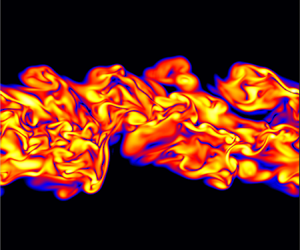No CrossRef data available.
Article contents
Transition to the buoyancy-dominated regime in a planar temporal forced plume
Published online by Cambridge University Press: 14 February 2025
Abstract

We study the transition from the momentum- to buoyancy-dominated regime in temporal jets forced by gravity. From the conservation of the thermal content and of the volume flux, we develop a simple model which is able to describe accurately the transition between the two regimes in terms of a single parameter representing the entrainment coefficient. Our analytical results are validated against a set of numerical simulations of temporal planar forced plumes at different initial values of Reynolds and Froude numbers. We find that, although the the pure jet-scaling law is not clearly observed in simulations at finite Froude number, the model correctly describes the transition to the buoyancy-dominated regime which emerges at long times.
- Type
- JFM Papers
- Information
- Copyright
- © The Author(s), 2025. Published by Cambridge University Press


